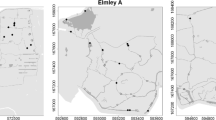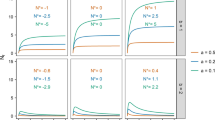Abstract
Mosquitoes are a major vector for tropical diseases, so understanding aspects that modify their population dynamics is vital for their control and protecting human health. Maximising the efficiency of control strategies for reducing transmission risk requires as a first step the understanding of the intrinsic population dynamics of vectors. We fitted a set of density-dependent and density-independent models to the long-term time series of six tropical mosquito species from northern Australia. The models’ strength of evidence was assessed using Akaike’s Information Criterion (AIC c ), Bayesian Information Criterion (BIC) and jack-knifed cross-validation (C-V). Density dependence accounted for more than 99% of the model weight in all model-selection methods, with the Gompertz-logistic (Cushing model) being the best-supported model for all mosquito species (negative density feedback expressed even at low densities). The second-most abundant species, Aedes vigilax (a saline breeder), showed no spatial heterogeneity in its density-dependent response, but the remaining five species had different intrinsic growth rates across 11 study sites. Population densities of saline species were high only during the late dry to early wet season following the highest tides of the month or early flood rains when swamps were mostly saline, whereas those of freshwater species were highest during the mid-wet and mid-dry seasons. These findings demonstrate remarkably strong density dependence in mosquito populations, but also suggest that environmental drivers, such as rainfall and tides, are important in modifying seasonal densities. Neglecting to account for strong density feedback in tropical mosquito populations will clearly result in less effective control.






Similar content being viewed by others
References
Agnew P, Haussy C, Michalakis Y (2000) Effects of density and larval competition on selected life history traits of Culex pipiens quinquefasciatus (Diptera: Culicidae). J Med Entomol 37:732–735
Akaike H (1973) Information theory as an extension of the maximum likelihood principle. In: Petrov BN, Csaki F (eds) Proceedings of the second international symposium on information theory. Budapest, Hungary, pp 267–281
Bergquist NR (2001) Vector-borne parasitic diseases: new trends in data collection and risk assessment. Acta Trop 79:13–20
Box GEP, Jenkins GM, Reinsell G (1994) Time series analysis: forecasting and control, 3rd edn. Prentice Hall, Englewood Cliffs
Bradshaw CJA (2008) Having your water and drinking it too—resource limitation modifies density regulation. J Anim Ecol 77:1–4
Bradshaw WE, Holzapfel CM (1989) Life-historical consequences of density-dependent selection in the pitcher-plant mosquito, Wyeomyia smithii. Am Nat 133:869–887
Bradshaw CJA, Fukuda Y, Letnic M, Brook BW (2006) Incorporating known sources of uncertainty to determine precautionary harvests of saltwater crocodiles. Ecol Appl 16:1436–1448
Brook BW, Bradshaw CJ (2006) Strength of evidence for density dependence in abundance time series of 1198 species. Ecology 87:1445–1451
Burnham KP, Anderson DR (2002) Model selection and multimodal inference: a practical information-theoretic approach, 2nd edn. Springer, New York
Burnham KP, Anderson DR (2004) Multimodel inference: understanding AIC and BIC in model selection. Sociol Method Res 33:261–304
Burrow JNC, Whelan PI, Kilburn CJ, Fisher DA, Currie BJ, Smith DW (1998) Australian encephalitis in the Northern Territory: clinical and epidemiological features, 1987–1996. Aust NZ J Med 28:590–596
Chamaillé-Jammes S, Fritz H, Valeix M, Murindagomo F, Clobert J (2008) Resource variability, aggregation and direct density dependence in an open context: the local regulation of an African elephant population. J Anim Ecol 77:135–144
de Little SC, Bradshaw CJA, McMahon CR, Hindell MA (2007) Complex interplay between intrinsic and extrinsic drivers of long-term survival trends in southern elephant seals. BMC Ecol 7:3
Dennis B, Taper ML (1994) Density dependence in time series observations of natural populations: estimation and testing. Ecol Monogr 64:205–224
Edgerly JS, McFarland M, Morgan P, Livdahl T (1998) A seasonal shift in egg-laying behaviour in response to cues of future competition in a treehole mosquito. J Anim Ecol 67:805–818
Elliott LP, Brook BW (2007) Revisiting Chamberlain: multiple working hypotheses for the 21st Century. BioScience 57:608–614
Freckleton RP, Watkinson AR, Green RE, Sutherland WJ (2006) Census error and the detection of density dependence. J Anim Ecol 75:837–851
Gilles M, Galloway D, Horwitz P, Larson A (2004) Reintegrating coastal development and public health in Western Australia. Ecohealth 1:340–350
Gimnig JE, Ombok M, Otieno S, Kaufman MG, Vulule JM, Walker ED (2002) Density-dependent development of Anopheles gambiae (Diptera: Culicidae) larvae in artificial habitats. J Med Entomol 39:162–172
Gratz NG (1999) Emerging and resurging vector-borne diseases. Annu Rev Entomol 44:51–75
Grech K, Maung LA, Read AF (2007) The effect of parental rearing conditions on offspring life history in Anopheles stephensi. Malaria J 6:130
Gubler DJ (1991) Insects in disease transmission. In: Strickland GT (ed) Hunter tropical medicine. Saunders, Philadelphia, pp 981–1000
Gubler DJ (2001) Prevention and control of tropical diseases in the 21st century: back to the field. Am J Trop Med Hyg 65:v–xi
Hall BH, Cummins C (2005) TSP 5.0 Reference manual, http://www.tspintl.com
Hanski I (1990) Density dependence, regulation and variability in animal populations. Philos Trans R Soc B 330:141–150
Juliano SA (1998) Species introduction and replacement among mosquitoes: interspecific resource competition or apparent competition. Ecology 79:255–268
Kiflawi M, Blaustein L, Mangel M (2003) Oviposition habitat selection by the mosquito Culiseta longiareolata in response to risk of predation and conspecific larval density. Ecol Entomol 28:168–173
Kunkel KE, Novak RJ, Lampman RL, Gu W (2006) Modeling the impact of variable climatic factors on the crossover of Culex restauns and Culex pipiens (Diptera: culicidae), vectors of West Nile virus in Illinois. Am J Trop Med Hyg 74:168–173
Lande R, Engen S, Sæther B-E (2002) Estimating density dependence in time-series of age-structured populations. Philos Trans R Soc B 357:1179–1184
Leonard PM, Juliano SA (1995) Effect of leaf litter and density on fitness and population performance of the hole mosquito Aedes triseriatus. Ecol Entomol 20:125–136
Link WA, Barker RJ (2006) Model weights and the foundations of multimodel inference. Ecology 87:2626–2635
Liu C, Broom AK, Kurucz N, Whelan PI (2005) Communicable Diseases Network Australia: National Arbovirus and Malaria Advisory Committee Annual Report 2004–05. Commun Dis Intell 29:341–357
Lukacs PM, Thompson WL, Kendall WL, Gould WR, Doherty PF, Burnham KP, Anderson DR (2007) Concerns regarding a call for pluralism of information theory and hypothesis testing. J Appl Ecol 44:456–460
Mackenzie JS, Smith DW, Broom AK, Bucens MR (1993) Australian encephalitis in Western Australia, 1978–1991. Med J Aust 158:591–595
McCarthy MA (2007) Bayesian methods for ecology. Cambridge University Press, Cambridge
Meehl GA, Washington WM, Santer BD, Collins WD, Arblaster JM, Hu A, Lawrence DM, Teng H, Buja LE, Strand WG (2006) Climate change projections for the twenty-first century and climate change commitment in the CCSM3. J Clim 19:2597–2616
Miller RJ, Wing J, Cope S, Davey RB, Kline DL (2005) Comparison of carbon dioxide and octenol baited encephalitis virus surveillance traps at the Shoalwater Bay training area, Queensland Australia. J Am Mosquito Contr 21:497–500
Mokany A, Shine R (2003) Oviposition site selection by mosquitoes is affected by cues from conspecific larvae and anuran tadpoles. Austral Ecol 28:33–37
R Development Core Team (2004) R: A language and environment for statistical computing. In: R Foundation for Statistical Computing, Vienna, Austria
Reiskind MH, Wilson ML (2004) Culex restuans (Diptera: Culicidae) oviposition behavior determined by larval habitat quality and quantity in southeastern Michigan. J Med Entomol 41:179–186
Rohe DL, Fall RP (1979) A miniature battery powered CO2-baited trap for mosquito-borne encephalitis surveillance. B Soc Vector Ecol 4:24–27
Russell RC (1987) Seasonal abundance, longevity and population age composition of potential malaria vectors in northern and southern Australia. Aust J Zool 35:289–306
Russell RC, Whelan PI (1986) Seasonal prevalence of adult mosquitoes at Casuarina and Leanyer, Darwin. Aust J Ecol 11:99–105
Sæther B-E (1997) Environmental stochasticity and population dynamics of large herbivores: a search for mechanisms. Trends Ecol Evol 12:143–149
Sæther B-E, Tufto J, Engen S, Jerstad K, Rostad OW, Skatan JE (2000) Population dynamical consequences of climate change for a small temperate songbird. Science 287:854–856
Saul A (2003) Zooprophylaxis or zoopotentiation: the outcome of introducing animals on vector transmission is highly dependent on the mosquito mortality while searching. Malaria J 2:32
Shone SM, Curriero FC, Lesser CR, Glass GE (2006) Characterizing population dynamics of Aedes sollicitans (Diptera: Culicidae) using meteorological data. J Med Entomol 43:393–402
Sibly RM, Barker D, Denham MC, Hone J, Pagel M (2005) On the regulation of populations of mammals, birds, fish, and insects. Science 309:607–610
Spiegelhalter DJ, Best NG, Carlin BR, van der Linde A (2002) Bayesian measures of model complexity and fit. J R Stat Soc B 64:583–616
Su T, Webb JP, Meyer RP, Mulla MS (2003) Spatial and temporal distribution of mosquitoes in underground storm drain systems in Orange County, California. J Vector Ecol 28:79–89
Sun DC, Tsutakawa RK, Kim H, He ZQ (2000) Spatio-temporal interaction with disease mapping. Stat Med 19:2015–2035
Sutherst RW (2004) Global change and human vulnerability to vector-borne diseases. Clin Microbiol Rev 17:136–173
Turchin P (1995) Population regulation: old arguments and a new synthesis. In: Cappuccino N, Price P (eds) Population dynamics: new approaches and synthesis. Academic Press, San Diego, pp 19–40
Turchin P (2003) Complex population dynamics: a theoretical/empirical synthesis. Princeton University Press, Princeton
Van Essen PHA, Kemme JA, Ritchie SA, Kay BH (1994) Differential responses of Aedes and Culex mosquitoes to octenol or light in combination with carbon dioxide in Queensland. Aust Med Vet Entomol 8:63–67
Wang G, Hobbs NT, Boone RB, Lllius AW, Gordon IJ, Gross JE, Hamlin KL (2006) Spatial and temporal variability modify density dependence in populations of large herbivores. Ecology 87:95–102
Whelan P, Merianos A, Hayes G, Krause V (1997) Ross River transmission in Darwin, Northern Territory, Australia. Arbovirus Res Aust 7:337–345
Whelan PI, Pettit B, Krause VL (2005) Dengue mosquito eradication project Tennant Creek end of January 2005 progress report. Bull Mosquito Contr Aust 17:16–23
Williams CR, Long SA, Russell RC, Ritchie SA (2006) Field efficacy of the BG-Sentinel compared with CDC backpack aspirators and CO2-baited EVS traps for collection of adult Aedes aegypti in Cairns, Queensland, Australia. J Am Mosquito Contr 22:296–300
Woiwod IP, Hanski I (1992) Patterns of density dependence in moths and aphids. J Anim Ecol 61:619–629
World Health Organization (1986) Resistance of vectors and reservoirs of disease to pesticides. 10th Report of the WHO expert committee on vector biology and control. In: WHO technical report Series, vol 737, pp 1–87
Yamamura K, Yokozawa M, Nishimori M, Ueda Y, Yokosuka T (2006) How to analyze long-term insect population dynamics under climate change: 50-year data of three insect pests in paddy fields. Popul Ecol 48:31–48
Zeng Z, Nowierski RM, Taper ML, Dennis B, Kemp WP (1998) Complex population dynamics in the real world: modeling the influence of time-varying parameters and time lags. Ecology 79:2193–2209
Acknowledgments
Funding for this project was provided by the Australian Research Council (LP0667619). We appreciate the support and assistance of N. Anstey, L. Bisevac, G. Boggs, D. Bowman, S. Cleland, B. Currie, S. Jacklyn, S. de Little, G. Morgan, G. Williamson and K. Mines. C.J.A.B. and B.W.B. conceived the research, and G.Y. was responsible for the analysis (with assistance from C.J.A.B. and B.W.B.). G.Y. took the lead in writing the manuscript, with equal contributions from C.J.A.B. and B.W.B. P.I.W. contributed to writing the manuscript. The data for this analysis have been provided by the Medical Entomology Branch DHCS and we thank the many staff over the years for their part in the collection of the data, and in particular to G. Hayes of MEB who arranged database access.
Author information
Authors and Affiliations
Corresponding author
Rights and permissions
About this article
Cite this article
Yang, GJ., Bradshaw, C.J.A., Whelan, P.I. et al. Importance of endogenous feedback controlling the long-term abundance of tropical mosquito species. Popul Ecol 50, 293–305 (2008). https://doi.org/10.1007/s10144-008-0082-8
Received:
Accepted:
Published:
Issue Date:
DOI: https://doi.org/10.1007/s10144-008-0082-8




